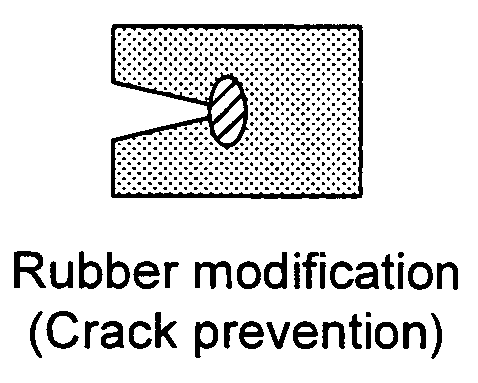Gas Tank and Method for Producing the Same
a technology of gas tanks and gas tanks, applied in the field of gas tanks, can solve the problems of increasing the weight of the outer shell, reducing the weight of the tank, and reducing the thickness of the pressure-resistant tank, so as to reduce the amount of permeation of hydrogen, reduce the amount of fine crack generation in frp, and suppress the effect of hydrogen permeation through the inner shell
- Summary
- Abstract
- Description
- Claims
- Application Information
AI Technical Summary
Benefits of technology
Problems solved by technology
Method used
Image
Examples
Embodiment Construction
[0030]FIGS. 1A and 1B schematically show a crack propagation mechanism in a matrix phase. FIG. 1A shows a conventional thermosetting resin in which elastomer particles and / or thermoplastic resin particles are not dispersed. In this case, cracks generated in the initial period propagate extensively. Meanwhile, FIG. 1B shows the thermosetting resin of the present invention in which elastomer particles and / or thermoplastic resin particles are dispersed. Even after crack generation in the initial period, good adhesiveness between particles of an elastomer or the like and a thermosetting resin phase is maintained. Thus, crack generation is prevented by particles of an elastomer or the like and cracks do not propagate extensively.
[0031]For the tank of the present invention, it is possible to use at least one type from among the following examples of high-strength and high-elastic-modulus fiber yarns as reinforced fibers (fibers for CFRP) that exhibit high strength: carbon fiber yarns, gra...
PUM
| Property | Measurement | Unit |
|---|---|---|
| particle size | aaaaa | aaaaa |
| particle size | aaaaa | aaaaa |
| particle size | aaaaa | aaaaa |
Abstract
Description
Claims
Application Information
 Login to View More
Login to View More - R&D
- Intellectual Property
- Life Sciences
- Materials
- Tech Scout
- Unparalleled Data Quality
- Higher Quality Content
- 60% Fewer Hallucinations
Browse by: Latest US Patents, China's latest patents, Technical Efficacy Thesaurus, Application Domain, Technology Topic, Popular Technical Reports.
© 2025 PatSnap. All rights reserved.Legal|Privacy policy|Modern Slavery Act Transparency Statement|Sitemap|About US| Contact US: help@patsnap.com



